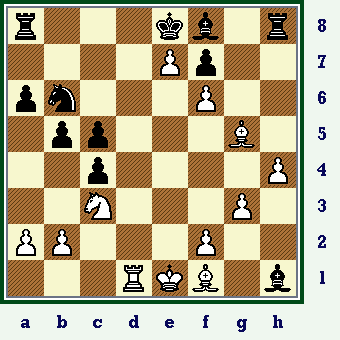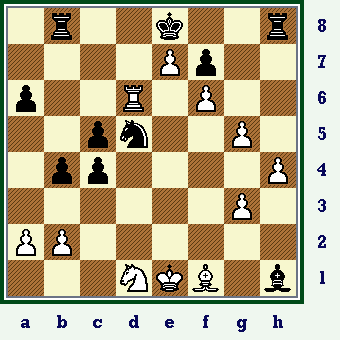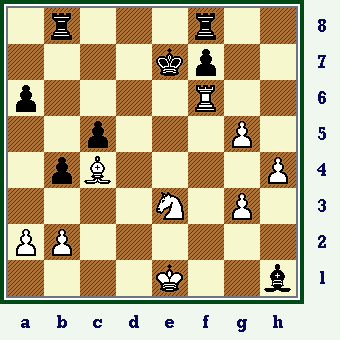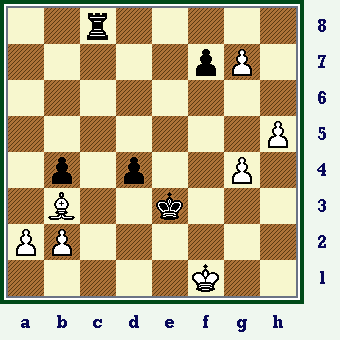GM L. Polugaeyevsky - GM E.
Torre;
|
This is a chess game that I started to analyze, but never really finished it. (At least not to a depth that I was satisfied with!) I also remember beginning on this game - more than once! - and having to lay it aside for various reasons. (Once, I did not have the necessary opening books to really do it justice. I don't play these lines, therefore I felt incapable of passing judgment on them, especially from just an opening book like ECO or MCO alone. Books like MCO are fine, but if you really want to try and understand a specific opening system; I have always felt that you should have at least one book dedicated to just that line alone. I now have about 15-20 books on the Slav, about four or five of them deal with this system in great detail. One book - see the bibliography at the end of the game - deals ONLY with the Botvinnik Gambit lines.)
*******
Another development that aided me greatly is the overall advance that computers {and chess programs} have made in the last few years.
And while computers cannot be trusted in some {very complex} endings and also are very poor at strategy, they are a tremendous boon to the analyst. If one uses a computer religiously during analysis, you need never worry about having missed an obvious tactic in your work.
*******
Literally dozens and dozens of fans (of my web pages) and also friends and chess acquaintances have written to me and asked that I do this game. It has been listed on various web sites of mine since the early 1990's. And it is in many, many, many books ... especially those that deal with the subject of the greatest games of all time. {Again - see the bibliography at the end of this game.}
Time and time again I have told friends that this game does NOT belong in any list of the "Greatest Games Ever Played." Most people are extremely perplexed by this, and usually ask, "Why not?" The best answer is that once White got away from his opening preparation, he failed - time and time again - to find the very best continuation. (Black also failed to find the best defense, Torre probably missed a relatively easy draw in this game.) But this game would certainly rate as one of the most important theoretical discoveries of the 20th Century!! (At one time - well before the Internet became popular - I subscribed to a huge number of chess magazines. And I clearly remember reading somewhere that these lines CLEARLY favored Black, and that ... "the onus was on the first player to discover any improvement." Polu's discovery certainly stood existing theory on it's ear!!)
Anyway, I certainly took longer to get around to this game than I originally intended ... nearly 15 years more! But I am now happy that this analysis is sufficient for my purposes - and may even correct one or two {minor?} errors in other people's work. So ... enjoy!!
Click HERE to see a fairly detailed explanation of all the symbols that I commonly use when I am annotating a chess game.
Click
HERE
to see this game ... (un-annotated),
on a java-script replay page.
(Warning! This is not my site!!! I am not responsible for
its content! If you do not like what you see or read, don't tell me - pls.
simply leave.)
Lev Polugaevsky (2620) -
Eugenio Torre (2550)
[D44]
International GM Tournament
Moscow, U.S.S.R; (R
#6); 08,04,1981.
[A.J. Goldsby I]
**********************************************************************************************************
Many call this one of the greatest games of all time. I prefer to be just a little more reserved than that.
The game is not perfectly played,
with a perfect finish ... this game might
have ended up a lot higher on my list.
{Not just on my lists, but probably
everyone else's as well.}
This is a great game by Polugaevsky.
It is also: A.) One of the greatest and
most important TN's of the whole of
the 20th Century;
B.)
A true and
absolute masterpiece of preparation.
(Some have said that 'Polu' was still
in his prepared lines almost to move
thirty. This is nearly unbelievable!!)
This is also one of the more wild
games that you will ever see. It looks
- and also feels - like fantasy chess;
not the normal, staid play that
Super-GM's normally engage in.
The game starts off as a Semi-Slav.
1.d4 d5;
2.c4 c6; 3.Nf3 Nf6; 4.Nc3 e6; 5.Bg5!?, (Maybe - '!')
{See
the diagram ... just below.}
A move that appears to be very
droll and routine ... but one that
can lead to some very extreme
and ABNORMAL tactics!!
*********************
*********************
The books are not even in complete
and total agreement over the name
of this line. Some call this continuation,
"The Botvinnik System."
Others call it
"The Anti-Meran Gambit." (A really
big misnomer, as this is NOT the
Meran Variation!)
But it does not matter what you call it, it certainly leads to some interesting tactics!
[ The
<< normal >> ... {official} "Meran Variation"
... begins with
the moves:
5.e3 Nbd7; 6.Bd3,
"+/=" 6...dxc4!?;
{Diagram?}
and White usually gets a solid
edge. [See MCO-14, page # 454.] ]
5...dxc4;
('!?') {Diagram?}
This move is not required ... if Black does not care for the wild
lines that now ensue, the second
player can always "opt out" ...
and play 5...Nbd7; or 5...Be7. (Either one of these choices would
probably lead to the 'normal' lines
of the QGD.)
Believe it or not ... what now
transpires - is all "book" stuff!!!
6.e4 b5;
Black plays to keep his Pawn -
otherwise the second player has
given up the center without a
valid reason.
7.e5 h6;
8.Bh4 g5;
Black saves the piece ...
(but gives the first player the
opportunity to sacrifice).
9.Nxg5! hxg5;
10.Bxg5 Nbd7!; 11.exf6!, {See
the diagram ... just below.}
This is best or correct. However,
for a long time, many books said
that this move was inaccurate -
mainly because of the continuation
that is played in this game.
*********************
*********************
As a result of this game, Black's idea that includes the move of 13...Nb6; is now considered to be completely refuted.
[ Fritz likes the move:
11.Qf3!?, {Diagram?}
which is probably inferior to the
text move (in this game).
[ See MCO-14, page # 473;
col. # 44, and also note # (e.). ]
********************************************************************************
By playing the moves: ("=")
11.g3!? Bb7; 12.exf6 c5; 13.d5! Qb6!; 14.Bg2,
"+/=" {Diagram?}
we simply transpose back to the
main lines of this while line. ]
11...Bb7;
(piece activity)
{See the diagram ...
just below.}
An extremely complex position
has arisen, White has an extra
Pawn, but Black has good play.
(Black has won dozens of nice
games at the "master-plus" level
with this wild and woolly variation.)
*********************
*********************
It is definitely a good place to take a look around here. Who says all double d-pawn lines are boring?
12.g3,
('!')
"Experience has shown that if White
wishes to fight for the initiative, then
his Bishop must go to g2."
- FM Graham Burgess. [ In the 'Mammoth Book.' ]
Actually, fianchettoing the KB
LOOKS extremely dangerous here ... I sincerely doubt any master would
even
try this, unless he (or she) was {already} familiar with the theory of this line.
[ Several students pick the move:
12.Qf3!?, "+/="
{Diagram?}
for White, here in this position.
{The move is not all that bad!} ]
12...c5;
('!')
Part of the plan ... Black unleashes
his Bishop on the long diagonal.
13.d5 Nb6!?;
(hmmm)
{See the diagram ... just below.}
This is the "old" system here, but
was widely held to be the correct
way to proceed for Black from this
position. FM G. Burgess, (in the
'Mammoth Book'); gives this move
an "inferior/dubious" sign here. ('?!')
I think that is rather unfair, as this is
the same guy who writes a lot of
books that endorse current theory.
Suffice it to say that before this game,
Black's move/idea was considered to
be fully playable ...
and even good
for the second player here.
*********************
*********************
The move certainly LOOKS fairly
reasonable, in fact it appears to win
material - due to the pin on the long
diagonal. I also think that any person
who is unfamiliar with theory might
choose this move ... 7 out of 8
players {students} that I tested this
position on did exactly that!!
[ The 'main line' {today} is:
>/= 13...Qb6!;
14.Bg2 0-0-0; 15.0-0 b4; {Diagram?}
The end of the column, here.
16.Rb1!, {Diagram?}
According to GM N. de Firmian,
this is the best move here.
*** *** *** *** *** *** *** *** *** *** *** *** *** *** *** *** *** *** ***
( The other way for Black to go
is the continuation of:
(>/=) 16.Na4, Qb5; 17.a3, exd5!?; 18.axb4, cxb4;
19.Be3, "~" {Diagram?}
with interesting play. ("Compensation?")
GM L. van Wely - GM A. Shirov; "The Melody Amber Tournament"
ICT / Masters (Inv. blind-fold) /
Monaco, 2004. (0-1, 39 moves.)
[ See MCO-14, page # 473; col. # 47, and also note # (n.). ]
[ See also the excellent book: "The Botvinnik Semi-Slav," by IM Steffen Pedersen. (Pg. # 24.) ] )
{I consider this line to possibly be the best bet for Black.}
*** *** *** *** *** *** *** *** *** *** *** *** *** *** *** *** *** *** *** *** *** *** *** ***
(Returning to the main line of our analysis here.)
16...Qa6; 17.dxe6!? Bxg2;
18.e7! Bxf1; {Diagram?}
This is probably best for Black.
*** *** *** *** *** *** *** *** *** *** *** *** *** *** *** *** ***
( Not to be recommended is:
</= 18...Ba8?!; 19.exd8Q+ Kxd8; 20.Ne2 Kc8; 21.Qc2 Qe6;
22.f3, '±' {Diagram?}
and according to the computer,
White has a won game here.
GM Alex Yermolinsky (2660) -
- FM Yury Lapshun (2350);
ICT / The World Open (#R7) /
Philadelphia, PA/USA; 1998.
(White won, 1-0, in 46 moves.) )
*** *** *** *** *** *** *** *** *** *** *** *** *** *** *** *** ***
(Once again, we return to the main path of our analysis
line, here.)
19.Kxf1! Qc6!?; {Diagram?}
The "book" move here.
( Was 19...bxc3; playable here? )
20.exd8Q+ Kxd8; 21.Nd5 Rxh2; 22.Kg1 Rh8;
23.Bf4, "+/=" ('±') {Diagram?}
White is better here - much better,
at least according to de Firmian in
Modern Chess Openings, 14th Ed.
(Fritz only sees a tiny edge for
White in this particular position.)
GM Pedrag Nikolic (2655) - GM
Alexei Shirov (2690);
ICT / 14th Super-GM Event /
Ciudad de Linares, ESP; 1997. (1-0 in 44 moves.)
[ See MCO-14, page # 473;
columns # 45 through col. # 48; esp. col. # 47, and note # (n.). ]
**********************************************************************************
*****************************************************************************
**********************************************************************************
Black can also play:
13...Bh6!?; {Diagram?} in this position;
as well as:
13...Nxf6!?; "~"
{Diagram?}
in this position. (See any good opening book.)
******************************************************
******************************************************
Black could also try ...Ne5!?
here. But after the moves:
13...Ne5!?; 14.Bg2 Nd3+!?; 15.Kf1 Qd7; 16.dxe6,
"~" {D?}
GM Lev Polugaevski says that
White is clearly better. ('±')
{See Informant, Vol. # 31. } ]
(Returning to our game here.)
14.dxe6!,
(Maybe - '!!')
{See
the diagram ... just below.}
White continues strongly ... even
brilliantly.
(In fact, many of my students
have asked me if this move was a
blunder by Polugaeyevsky here!)
*********************
*********************
But this is all part and parcel of the first player's very deep opening idea.
[ Interesting was: 14.Nxb5!?, "~" with maybe an edge to White. ]
The next few moves look to be
close to being forced here.
14...Qxd1+;
15.Rxd1 Bxh1;
Black is now ... up a whole freaking
Rook ... for just a couple of very
insignificant {looking} buttons.
Take a look {at this position} ... many of my students have even said that White should resign in this position.
*****************************************************************************************
White's next move seals in Black's
whole King-side. (Some students
have suggested 16.e6xP/f7+, but
this is
substantially weaker than
the move actually played in the
game here.)
16.e7,
('!')
16...a6; ('!?') {Diagram?}
Torre continues blithely along ... completely unaware he is about
to have a theoretical bomb
dropped on him.
But to be fair,
16...a6; was the move that was
recommended by theory ... at
least at the time that this game
was actually played.
This is a very interesting position,
and it would be easy to assume that
Black - who has an extra Rook -
has a very easy win here.
[ Possible was:
16...Bc6!?;
"~" {Diagram?}
with a totally crazy position ...
that is not completely unfavorable
to the second player here.
************************************************************************
A cute trap would be:
</= 16...Bh6?;
17.Nxb5! Rc8?; {Diagram?}
A terrible mistake ... but Black
is lost in any case.
( Or if >/= 17...Nd5[]; then White
simply plays the move:
18.Bh3!, "+/-" winning easily. )
18.Nc7+! Rxc7; 19.Rd8#. ]
17.h4!!,
(TN) (Maybe - '!!!')
{See
the diagram ... just below here.}
This brilliant move is the point
of White's play here. (And one
of the most significant innovations
in opening theory
for the whole
of the Twentieth Century. It very
dramatically reversed the theory
of this whole line!!!)
*********************
*********************
<< Polugaevsky had cooked up this astonishing idea in his "laboratory" at home. >> - FM Graham Burgess.
*******
The editor of
< British Chess Magazine > (GM Murray Chandler); once printed
a list of the "Ten Greatest Chess Moves of All Time."
(BCM - 1998) This move, 17.h4!!, was number six (# 6) on that very famous list.
(Tim Krabbe also ranks this in his list
of the 110
Best Chess Moves ... ever!)
[ White had previously played:
17.exf8Q+!? Kxf8!;
{Diagram?}
This is probably best.
*** *** *** *** *** *** *** *** *** *** *** *** *** *** *** *** *** *** *** ***
( Black should not play:
</= 17...Rxf8?; 18.Rd6 Nd7; 19.Bf4 0-0-0; 20.Bh3,
'±' {Diagram?}
and White is much better.
J. Smejkal - J. Bednarski; SWE/1975/1:0 (43) - Informant # 20 / Game # 578 )
*** *** *** *** *** *** *** *** *** *** *** *** *** *** *** *** *** *** *** ***
18.Rd6 Rb8; 19.Be3 Rh5; 20.Be2 Re5;
21.Kd2!?, {Diagram?}
This does not look all that great,
but it is hard to find any meaningful
improvements
for White in this
position.
*** *** *** *** *** *** *** *** *** *** *** *** *** *** *** *** *** *** *** *** *** ***
( White could also try:
(>/=) "=" 21.Nd1 Kg8; 22.Bf4 Ree8; 23.Ne3
Be4!; "=/+" {Diagram?}
and Black has the better chances
from this position - at least,
according to FM G. Burgess.
GM Alexander Beliavsky - GM Vladimir Bagirov;
ICT / Masters (Four teams) /
Moscow, U.S.S.R; 1981.
(This game was fairly long ... {50+}
and was eventually drawn.) )
*** *** *** *** *** *** *** *** *** *** *** *** *** *** *** *** *** *** *** ***
21...b4; 22.Nd1 Kg8!;
"=/+" {Diagram?}
Black is slightly better in this
position.
J. Plachetka - V. Bagirov; Berlin/1979 / 0:1 (38) - Informant # 28 / Game # 579 ]
17...Bh6!;
{Box?}
This is probably best.
(Several strong computer programs
believe Black to be winning easily
in this position.)
[ Not quite as effective would be:
</=
17...b4!?; 18.exf8Q+ Kxf8;
19.Ne2,
19...Na4;
"~" {Diagram?}
and Black could be slightly better. ]
18.f4!!, Belov: - '× Rh8'
This move is the real point of
White's idea ... White's K-side
Pawns are impressive, and keep
Black's KR completely blocked
out from any meaningful play.
Polugaevsky commented here
that he had no intention of trying
to regain the lost material, but
preferred to maintain his initiative
and keep Black's pieces out of
the game.
[ </= 18.Rd6 Bxg5; 19.hxg5 Rb8; "-/+" ]
18...b4!?; 19.Rd6!,
The most active move for White.
"Only this energetic follow-up justifies White's idea" (here). - IM Steffen Pedersen
[ Or 19.Nb1, "=" - Belov ]
19...Rb8!,
(forced?)
This is best ... despite the second
player's extra Rook, it is not easy
to find good moves for Torre in
this position.
A few students have said that Black should play ...Nc8??? here, but missed that White has Rd8 mate.
[
Bad for Black would be the
following continuation:
(</=)
19...bxc3!?; ('?!')
{Diagram?}
This is probably unwise here.
20.Rxb6 cxb2!?; {Diagram?}
Having said "A," Black now feels
he must compliment this with "B."
( </= 20...c2?!; 21.Kd2 Kd7?; 22.Bxc4 Be4; 23.Kc1!, '±' )
21.Bxc4!,
"+/=" ('±') {Diagram?}
White is clearly better.
Analysis by - IM Igor Belov ]
White's next move is both best ... and virtually forced.
20.Nd1
Bxg5; 21.fxg5 Nd5!;
{See the diagram - just below.}
Black - who is probably sick of
White's terrific bind - decides to
sack back a piece to liberate his
King's Rook.
(This might be the only
way to get the ox back into play.)
*********************
*********************
Some have criticized this idea by
GM Torre. But these same pundits
who berated Torre's decision here,
never came up with a meaningful alternative - to address the plight of
Black's helpless KR.
[ After the plausible moves:
</= 21...Bd5!?;
22.Ne3 Be6!?; 23.Bg2 Bd7; 24.Be4,
'±' {D?}
and with Nf5 on tap, White
has a very powerful initiative. ]
22.Bxc4 Nxe7!?;
23.fxe7 Kxe7;
Black appears to be freeing himself.
24.Rf6!,
(wow)
White foregoes the gain of material
to maintain the initiative.
'!' - FM Graham Burgess
[ Polugaevsky gave the line:
(>/=) 24.Rxa6!? Rhe8!; 25.Rf6
Kf8+, "~" {Diag?}
(Intending ...Re7; next.); and
stated that the position was very
unclear.
But I think that White is solidly better. ('+/=' or '±') ]
24...Rhf8;
25.Ne3!?, (Maybe - '!') {See
the diagram ... just below.}
It looks more natural to attack
the Bishop ... but Polugaevsky
finds the best move for White.
*********************
*********************
This is a very unusual position.
[ 25.Nf2!?, "+/=" (With the idea of Nd3 next.) - Belov ]
25...Be4;
26.Rxa6, '±' ('!')
"In return for the exchange, White
has two Pawns and his pieces are
more active."
- FM Graham Burgess (Who gets a special award for his
talent for stating the obvious!)
[ Interesting is:
26.h5!?,
'±' {Diagram?}
also with an advantage for White
in this position. {A.J.G.} ]
26...Rbd8;
27.Rf6!?, (Maybe - '?!')
Thus far, GM Lev Polugaevsky has
been following his home analysis ...
which is almost a super-human
feat, at least when you have had a
chance to think about it.
But now,
thrown upon his own resources, he
begins to go wrong.
It is this phase - - - where White
begins to play less-than-best moves
- - - that causes me to
believe that
this game is NOT one of the true
immortal games of chess.
[ Maybe better would have
been
the following continuation:
(>/=) 27.h5! Rde8;
{Box?} {Diagram?}
This could be best.
( Not: </= 27...Rg8?!; 28.g6! , '±' {Diagram?}
when White is probably winning
in this position. {Burgess} )
28.Ke2 Rh8; 29.g4 Ra8; 30.Rb6!,
'±' {Diagram?}
and White is MUCH better ... according to Fritz 8.0.
]
27...Rd6;
28.Rf4!?, ('!')
{Diag?}
White prefers not to exchange.
[ Or 28.Rxd6 Kxd6; 29.h5, "+/=" ]
28...Rd4;
This move makes good sense to
me, although the machine prefers
another move for Black here.
[ The box likes:
</= 28...Bg6!?;
{Diagram?}
but this might allow Nd5+,
followed by Nf6. Black would
then die the slow death of
asphyxiation. ]
White's next move is probably
best ('!') ... from a number of
possible alternatives.
29.h5 Bd3!;
A very tricky move ...
that is also the first choice of
several strong computer programs.
(Almost all the significant masters
who annotated this game - also
awarded this move an exclam here.)
30.Nd5+!;
(hmmm)
Everyone, and I do mean just
about EVERYONE ... (Polu,
Belov, Burgess, Bagirov, etc.);
all give this move an exclam.
(So I follow suit.)
But is this move really the best one for White in this position?
[ After the seemingly obvious
moves:
(>/=) 30.Rxd4!? cxd4;
31.Bxd3 dxe3; 32.Ke2,
'±' (Maybe "+/-")
{Diag?}
White seems to be hugely better.
(Help me ... Spock!! Where is Pal Benko when you need him?) ]
30...Kd6;
31.Rxd4 cxd4; 32.Bb3?!; (Ummm.)
Both Belov, and Polugaevsky - in
the Informant - and also FM G.
Burgess ... give this move an
"inferior" sign.
(I would be tempted
to award a whole question mark
to Black for this move.)
'?' - GM Peter Wells
"Sadly, after his magnificent play
so far, Polugaevsky starts to misplay
the ending."
- FM
Graham Burgess
[ White has a relatively simple
win - by playing the following
moves,
that are seemingly fairly
simple to discover:
>/= 32.Bxd3! Kxd5; 33.h6! Rg8;
{Diagram?}
This looks somewhat suspect. (Maybe 33...Kd6!?; immediately?)
( Or 33...Rh8!?; 34.Kf2 Kd6; 35.Kf3 Ke7?;
36.Kg4 f6; 37.Kh5!, "+/-" {Diagram?}
{White plans Kg6-g7!, hitting the R.}
and White is winning. - GM Lev Polugaevsky )
34.h7 Rh8; 35.Kd2 Kd6; 36.Kc2 Ke7;
37.Kb3 Kf8; 38.Kxb4 Kg7;
39.Kc4, "+/-"
{Diagram?}
- Belov and Polugaevsky.
]
32...Bc2!?;
(hmmm)
About a dozen different annotators
give this move an exclam. {'!'}
(For example: - Bagirov, Belov,
Burgess, Korchnoi, Pedersen,
Wells, etc; all praised this move.)
But to me this looks like a bad attempt at a swindle, ('?!') the move of ...Rg8; ('!') looks much steadier.
To be fair, Torre was in horrendous
time pressure here, having used
nearly all of his time earlier in the
bottomless abyss of complications.
[ Or (>/=) 32...Rg8!?; 33.Nxb4, "+/=" {Diagram?} (and) White looks to be a little better. ]
33.Bxc2!,
(yes)
'Polu' refuses to be bluffed or
intimidated ... thus the exclam.
[ White could try: 33.Bc4!?, {Diagram?} offering to repeat. ]
Now E. Torre has to take on d5...
else he faces two pieces versus
a lone rook -
a nearly hopeless
scenario for Black.
33...Kxd5[];
34.Bb3+?,
Very bad. After his earlier play -
which bordered on the sublime - Polugaeyevsky plays a move ...
which
could have thrown away the win!
'?' - GM Peter Wells
Burgess, Belov, and Polugaevsky
all award this move a full question
mark here. ('?') Normally, anytime
a player plays a move that throws
away a win, I would award that
move TWO
question marks! ('??')
[ White wins after:
>/= 34.h6! Re8+!?;
{Diagram?}
Black has few good moves here.
( </= 34...Rg8?; 35.Bb3+! Ke5; 36.Bxf7, "+/-" )
35.Kd2 Ke6!?; 36.a4!,
("+/-") {Diagram?}
The Black King cannot approach,
and the Rook will not be able to
handle Passed Pawns on both
sides of the chess-board. ]
34...Ke5;
35.g4 Kf4?; ('??')
This plausible-looking move ...
is actually a blunder that throws
away an almost sure draw.
[See Burgess's analysis in the
'Mammoth Book' for the full
'low-down' {very detailed} of
how Black draws after 35 g4.]
[ The main line of Burgess's
analysis runs like:
>/= 35...d3!;
36.Kd2!? Kd4!; "=" {Diagram?}
and White will be unable to make
any progress from here. ]
36.g6!,
('±±') {Diagram?}
Back on the right track.
'!' - FM Graham Burgess
"Now after his {slight} hiccup, White is" (now) "winning again." - FM Graham Burgess
[ </= 36.a4 bxa3; 37.bxa3 Kxg5; "/+" ]
Black cannot capture on g6, as then the pawn advance of g6-g7 will be fatal for the second player.
36...Ke3?!;
(Maybe just - '?')
A transparent - and somewhat
feeble - attempt by Torre ... that
only makes matters much, MUCH
worse for Black!
[ Black loses a very attractive
variation - after the moves:
>/= 36...fxg6!?;
37.hxg6! Re8+; {Diagram?}
Black may as well.
( Or if: 37...Kxg4!?; then 38.g7,
{Diagram?}
and White has a relatively simple
win ("+/-") from here. )
38.Kd2! Re7!?; 39.Bf7!!,
{Diagram?}
and White wins. ("+/-")
(Analysis by IM Igor Belov.) ]
37.g7 Rc8;
38.Kf1!, {See the diagram - just below
here.}
While some actually criticized this
move for White, it is the first choice
of the box ... by a very wide margin!
*********************
*********************
For a long time, (years and years);
MANY annotators - like IM Belov
in ChessBase (database) - claimed
that h6 was better
than this move. (And they were all dead wrong!!!)
[
</= 38.h6!?, ('?')
- IM Igor Belov
(Burgess points out that this
move actually allows Black to
escape with a draw!) ]
38...d3!?;
39.Kg2!? Kf4; 40.h6, ("+/-")
{Diag?}
In a completely lost position,
apparently Black LOST on TIME. (1-0)
(If 40...Rc2+!?; simply 41.Kh3!
Black cannot stop White's Pawns
from promoting - en masse.)
One of the more interesting games
of the period 1950-2000, and also
a real masterpiece of opening
preparation by GM L. Polugaevsky.
(Unfortunately the uneven play ...
by BOTH participants ... especially
in the later phases of this game,
disqualify it from being one of the
absolute all-time best.)
****************************************************************************************************
****************************************************************************************************
BIBLIOGRAPHY:
I consulted the following resources
to annotate this game. (Given -
roughly - in the order that I
consulted these references.)
{NOTE: I have seen this game
dozens of times in print. I have
purposely ignored the volumes
where I feel that the objectivity
of the author is questionable.} (Underlined sources
generally refer to a book.)
# 1.) [The MAMMOTH BOOK Of] "The World's
Greatest Chess Games,"
by GM John Nunn, GM John Emms,
and also FM Graham Burgess.
Copyright (c) 1998. (The authors.) Published by Carroll & Graf.
(In the UK by Robinson Pub.)
(Edited by Burgess & Nunn in
England for Gambit Publications, Ltd.)
Printed and bound in the EC.
ISBN: # 0-7867-0587-6
# 2.) Informant # 31, Game # 468. (Analysis by GM Lev Polugaevsky.)
# 3.) Analysis in the CB database. (By IM Igor Belov.)
# 4.) "The Botvinnik Semi-Slav,"
by IM Steffen Pedersen. (Pg. # 24)
Copyright (c) 2000 by the author.
PUB: Gambit Publications, LTD.
(London, England; UK / NY-USA) ISBN: # 1-901983-26-9
# 5.) A book of Polugaevky's games. (In Russian.)
# 6.) < Chess Highlights Of The
20th Century, > by FM Graham Burgess.
[The best chess, 1900-1999; in a
historical context.] {Hard-back.}
Copyright (c) 1999, by the author.
By: Gambit Publications, Ltd.
(London, England.)
ISBN: # 1-901983-21-8
# 7.) "The COMPLETE Semi-Slav,"
by GM Peter Wells.
(I think he was only an IM when he
first published this book.)
Copyright (c) 1994, by the author. Published by Henry Holt books.
(Owl Books, New York / USA.) ISBN: # 0-8050-3288-6
(I also consulted MCO, ECO, BCO, and many other references as well.)
*******
This game is also in the - relatively new - volume:
"Garry Kasparov On My Great
Predecessors, Part III," by Kasparov
and also NM Dimitry Plisetsky.
(Game # 28, page # 104.)
I am not sure, but I don't think I had this book (yet) when I first began work on this game. (March 09th, 2005.)
*************************************************************************************************
*************************************************************************************************
Copyright (c) A.J. Goldsby, 2004, 2005 & 2006. All rights reserved.
1 - 0
This game - the raw HTML code was {initially} generated with the program, ChessBase 8.0.
This is not the original version of this game that I first worked on. {That version was easily a small book.} I lost that version of this game in one of my many computer crashes. (Actually, I may have one copy on a tape back-up. But since the manufacturer will not update that software for Windows XP/OS, I have no way of accessing it.) That copy or version of this game would have run at least twenty (or more!) pages - and had very few diagrams. There was also a copy of a lot of 'book' theory in that version as well.
*******
Since I had lost most of my original analysis, I was forced to go back to "a clean sheet of paper," so to speak, for this game. When I first started working on this game, (this time around) - in January of 2001 - I only wanted to do a very quick version, something I could knock out in maybe a day or so. However, the more I worked on this game, the more I realized that this would not be possible. (The analysis would be very superficial, and nearly meaningless. The average player would have far too many questions ... that would have been left, for the most part, completely unanswered. And this was not really my vision for this game. I wanted something that was more worthy of this encounter.)
What I {slowly} created - over a period of nearly three years - was this version of this contest.
---> This is not
my original version of this game, exactly as I created it in
the original ChessBase format.
(This version of this game in my ChessBase files runs more
than 15 pages - if you bother to print it out.)
(I have deleted most of the diagrams
from this version, and only slightly edited a few of the longer variations.)
************** ************** **************
March, 2005: I just got an e-mail from a FIDE-titled player, he did not give me permission to use his name.
He is a well-known writer, having published several chess books. He stated that he went over this page in some detail, stopping to check key variations ... and that he also used a computer and a D.M.P. as well. He said that he thought he would find errors, but after several days of searching for any mistakes in my analysis, ... he gave up and quit. He passed along his compliments on this page and on a job well done.
If you
have any questions about this game - please contact me.
A.J. Goldsby;
P.O. Box 11718; Pensacola, FL 32524 (USA)
[ I
no longer offer the CB version of any game. Too many
people that will not respect ANYONE's copyright!!
However, if you request it - and are willing to pay a fee to cover
printing costs and postage, I will gladly send you the printed, ChessBase copy
of this game.]
Copyright (c) LM A.J. Goldsby I
Copyright (©) A.J. Goldsby, 2009. All rights reserved.
*******
This page was created in August of 2004. I finished annotating this game sometime in September (or October), 2004.
The final formatting of this page was completed on: Tuesday; October 5th, 2004.
This page was last modified or edited on: Tuesday, August 04, 2009 06:36 AM .
[ Home, (for this site). ] [Return (or go to) to "Annotated Games." (#1)] [ Top of (this) page. ]
[Return (or go to) to the (page for) "Best Games."] [ Go to my personal domain. ]
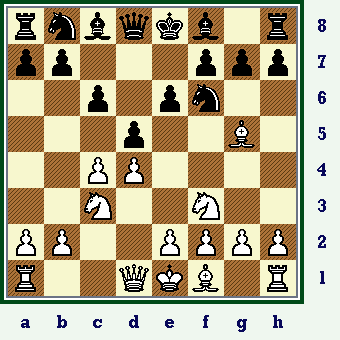
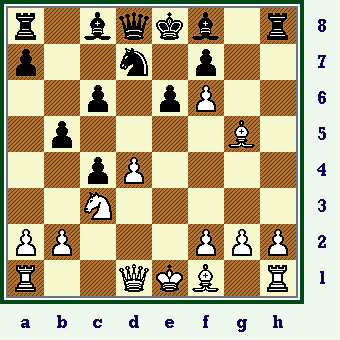
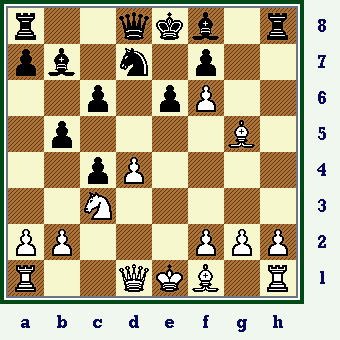
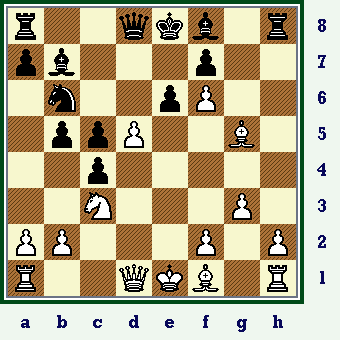
![The position just after White captures on e6 with his Pawn, (move 14). [ pol-tor_mosc81-pos5.gif, 10 KB ]](pol-tor_mosc81-pos5.gif)
